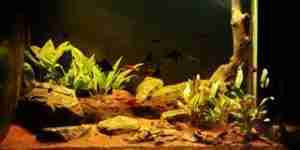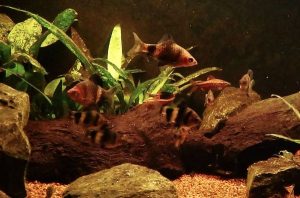Nilwala Basin Sri Lanka Biotope Tank
by Jeroen Vanhooren
 Biotope: Near the riverbank of a small stream in the Nilwala basin (Sri Lanka)
Biotope: Near the riverbank of a small stream in the Nilwala basin (Sri Lanka)
Dimensions: 70*50*35 (l*d*h)
Technical description:
Lightning: An Aquatlantis Easy Led 6800 K (28 W) – on timer control.
Filter: An internal sump with two sizes of filtration media and biological filtration medium. A pump of 100 liters per hour circulates the water.
Substrate: Brown aquarium gravel one to two millimeters in size. Different sized rocks, a log, leaves and some alder cones were used.

Water change: Automatic with 2 episodes of adding fresh water each day by a dripping system.
Temperature: Controlled by an aquarium heater of 200 W. Water temperature in these streams is relatively cool at 24-26°C and is fairly constant. This is due to stable air temperature and shade of overhanging forest canopy.
Plants: Lagenandra thwaitesii and Cryptocoryne beckettii
Fish: Puntius titteya along with Pethia nigrofasciata
 Biotope description: This aquarium simulates the riverbank in a small stream of the Nilwala basin at an elevation of around 200 m. At this elevation Pethia nigrofasciata and Puntius titteya could be found together. They are endemic to the wet zone in south western Sri Lanka and inhabit the lowland tropical rainforest streams there. Huge amounts of rainfall occur in the wet zone because of the monsoons between March and August.
Biotope description: This aquarium simulates the riverbank in a small stream of the Nilwala basin at an elevation of around 200 m. At this elevation Pethia nigrofasciata and Puntius titteya could be found together. They are endemic to the wet zone in south western Sri Lanka and inhabit the lowland tropical rainforest streams there. Huge amounts of rainfall occur in the wet zone because of the monsoons between March and August.
These streams are shaded because of the overhanging forest canopy. Water is slightly acidic, soft, and clear. There are only a few macrophytes in these areas but marginal vegetation could be dense. It is an ideal place for smaller fishes to hide from predators like Channa orientalis.
Typical substrate is sandy with some small rocks and a layer of leaf litter.
Other fish found in these streams are Rasboroides vaterifloris, Puntius bimaculatus, P. kelumi, Pethia nigrofasciata, Dawkinsia singhala, Schistura notostigma, Mystus vittatus, Aplocheilus werneri, Channa orientalis, Malpulutta kretseri, and Mastacembelus armatus.
Sadly enough the Sri Lankan rainforest is under a terrible amount of threat to habitat. In 2006 only 4.6 % of the original rainforest was intact as a result of plantation activity. This is of course quite impactful for these vulnerable ecosystems.
 Biotope One A Study of Flora and Fauna
Biotope One A Study of Flora and Fauna 


